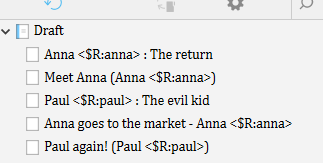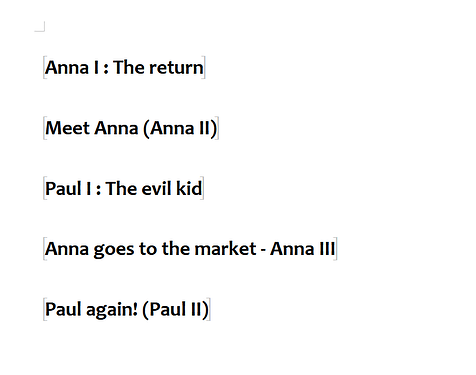That’s what I was thinking, too. Why complicate things?
I have difficulties with numbers (dyscalculia), so I like automating anything that’s number-related xD
Thank you for your patience with my posting. I’ve learned something. Respect.
I maybe stupid by why not skip the numbering schemes and title the chapters in the binder Anna I, II, Iii etc and have the chapter layout include the Title ie Binder title and don’t need anything else.
Dyscaulculia would make that pretty hard (being neurodivergent sucks sometimes).
Well, if you don’t get through with the automation, note that as I said before, you could simply insert <$R:anna> or <$R:paul> in your binder titles.
No need to deal with numbers.
Nor to design and assign specific section types/layouts.
Compiled:
See? You can do whatever you want. You can have the number appear anywhere you want it in the title. And it can change place from one title to another. (A section layout doesn’t allow that.)
(The above took me about 3 minutes. Design, compile, post here.)
Love it. Never would have thought to do that.
For the issue of calculating if do by hand could make a key document.
a=I
b=II
c=III
d=IV
Etc and have a friend supply the correct Roman numeral for the letter and use the completed key to substitute.
With the exception of readers with dyscalculia.
May I ask why an author with dyscalculia of all people wants to use Roman numerals? Is your manuscript part of a series or an anthology, and are you required to use Roman numerals?
In that case, for a purely compile-based solution that does not require excessive setup (like having different section types for each character POV), you would want to do something like this:
- The
<$title_no_spaces >placeholder takes the binder title of the item and removes the spaces (funnily enough), which produces something useful for things like this, where spaces might confused computers. - So now we can automatically insert the name of the item into a specific spot in our compile settings, and since numbering placeholders can take names (as describe already in this thread), to sequence different streams of numbering in parallel, we now have a way of automatically generating named numbering streams based purely upon our naming conventions:
<$R:<$title_no_spaces >>.
When the compiler encounters that placeholder on an item called “Anna”, it will internally create this placeholder, <$R:Anna>, which then in a second sweep of placeholders becomes “XII”, or whatever it should be at that point in the manuscript.
So going by that principle, and looking at the placeholder options in the list, you can see how this can be used for other schemes as well, such as using the colour Label to mark POV, instead of the item name <$R:<$label>>.
Here is a simple sample project demonstrating the idea:
numbering_by_pov.zip (137.8 KB)
Let me explain: dyscalculia only means having difficulties understanding math/big numbers. It doesn’t mean having an aversion to them.
All I wanted to do was format a book in the style of ASOIAF (granted, the books themselves don’t use numerals - that’s a reader convenience in forums).
Amber, this is amazing!
So just to see if I’ve gotten this straight:
To get my desired workflow in place, I’d need to use <$title_no_spaces > before adding the <$R> tag when creating my compile format, which could then produce something like this:
IAPETUS I - The Journey
IAPETUS II - Arriving in Gath
IAPETUS III - The Plan for Regency
And so on and so forth.
I’m not sure exactly what you mean by that, but the example I gave in the second bullet point above is precisely how you want to type it. Just imagine the title_no_spaces bit becomes ‘word’, as it will to Scrivener, and think <$R:word>. That’s what you want it to “see” when it comes time to number things. Many instances of <$R:word> will count up normally, like <$R> would by itself, but the moment you use <$R:word2> it starts over for that one, from one. That is what we mean by having multiple “streams” of numbering using the same counter type.
So as long as <$R:word> points to a different word (ex: a new POV character), the numbering will be normal?
Exactly, each word that you add after the R: will be counted separately, starting from one. If you have not tried it yet, compile the example project I attached, as it shows how each folder name is counted separately from the other folder names that don’t match. They are mixed up deliberately to demonstrate this.
I did compile your sample project. Gives me an idea of what to do.
Thanks very much, Amber!
@AmberV: I tried to follow copy your format exactly but the placeholder shows in the final document.
As I mentioned before, I have a specific format I want to follow (example below):
SVIATOSLAV I - THE WARD OF THE CROWN (folder)
Four scenes go in the folder
Perhaps typing it out is better than copy and paste if that is what you doing. Maybe your browser isn’t translating the characters literally enough.
Will try that and report back (:
I will say, with this, I premised my example based on the original description (I must have missed the update where this was described), of the folder being simply called “SVIATOSLAV” and not all of the stuff before and after.
You might in that case want to switch to the Label-based approach I suggested, for marking POV (or anything, label is just a common tool for that). Labels can be inserted into the heading too. For example you could have a Prefix like this:
<$label> <$R:<$label>> -
And then let the Title checkbox handle adding the “The Ward of the Crown” bit, which would be the entirety of your folder name.
I’ll try that!
I generally like to configure compile before I begin a project so I can set and forget it.
I’ll ask, though: Do I have to use label exactly? Or does “label” become whatever POV Character I'm writing?

